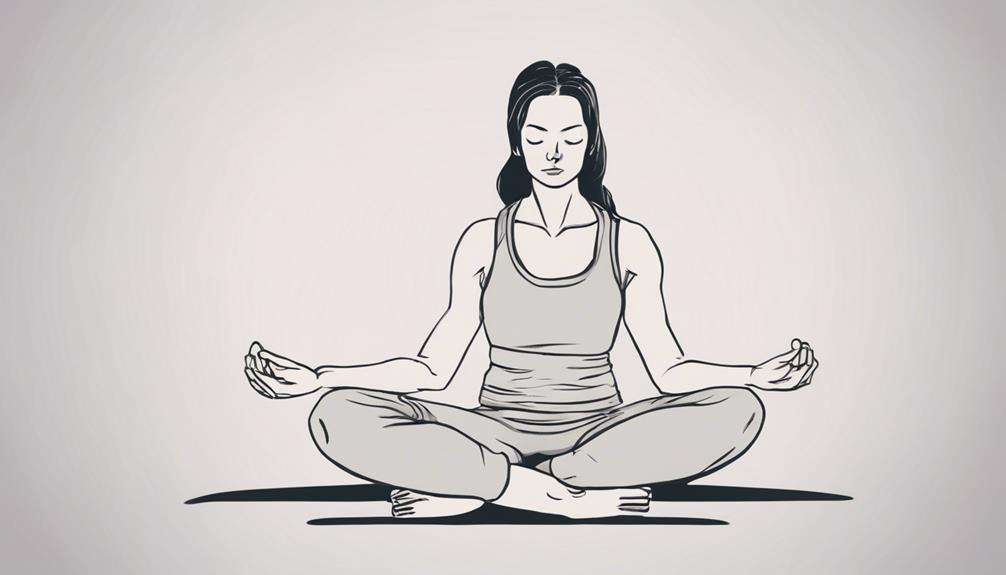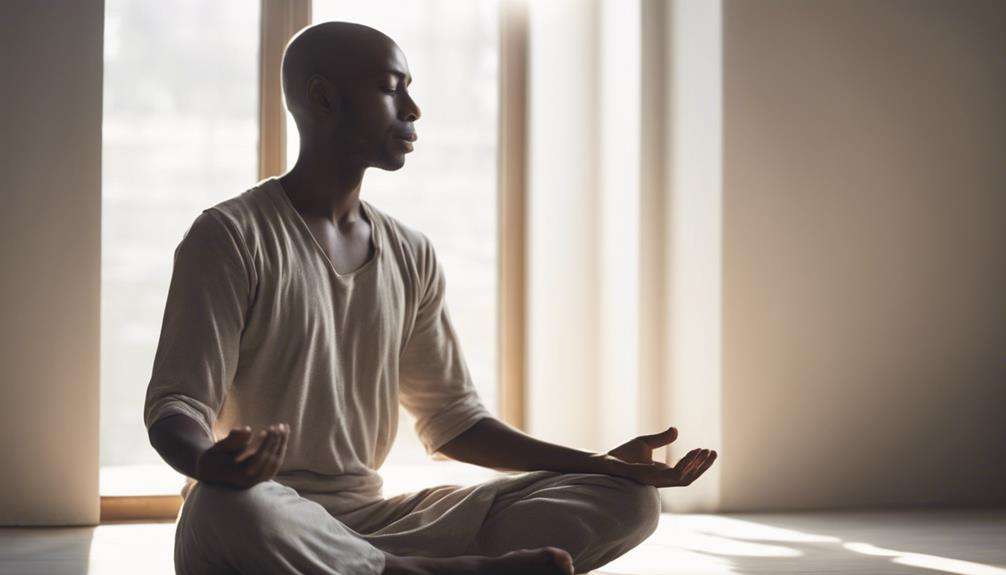You might think meditation is just for yogis and spiritual gurus, but did you know it could also help with your blood pressure? Lowering those numbers can lead to a healthier heart and a more relaxed mind.
Curious to find out how these 10 different meditation practices can be your ticket to a calmer, healthier you?
Key Takeaways
- Deep Breathing Meditation reduces heart rate and promotes relaxation.
- Body Scan Meditation eases tension and enhances mindfulness.
- Loving-Kindness Meditation fosters empathy and emotional well-being.
- Visualization Meditation induces relaxation and supports cardiovascular health.
Deep Breathing Meditation
Deep breathing meditation, a simple yet powerful practice, involves focusing on full inhalations and long exhalations to effectively lower blood pressure. By concentrating on the breath without attempting to alter its natural rhythm, you can induce a state of physical relaxation and reduce your heart rate.
Visualization techniques, where you mentally connect your breath with feelings of calmness and serenity, can enhance the benefits of deep breathing meditation. This practice can be done in a comfortable position, making it a complementary approach to traditional methods for managing high blood pressure.
Research supports the efficacy of deep breathing meditation in promoting relaxation and potentially aiding in blood pressure control. By incorporating this practice into your daily routine, you may experience the positive effects of reduced stress and improved cardiovascular health.
Take a few moments each day to engage in deep breathing meditation and witness its impact on lowering your blood pressure.
Body Scan Meditation
Body scan meditation offers a structured approach to cultivate body awareness and ease tension throughout your entire body.
This practice involves sequentially focusing on different body parts, promoting relaxation and stress reduction.
Benefits of Body Scan
Engage in the practice of body scan meditation to enhance your awareness of physical sensations and promote relaxation for improved stress management and overall well-being.
Body scan meditation involves systematically focusing on different body parts to increase mindfulness and relaxation. By tuning into physical sensations, individuals can identify areas of tension and release stress held in the body, potentially reducing blood pressure.
Research suggests that regular practice of body scan meditation promotes relaxation and mindfulness, contributing to better stress management. This practice not only enhances the mind-body connection but also helps in reducing physiological responses to stress.
Incorporating body scan meditation into your daily routine may result in improved overall well-being and a calmer, more relaxed state of being.
Steps for Body Scan
To start practicing body scan meditation effectively, begin by finding a quiet and comfortable space where you can relax and focus on your breath. Body scan meditation involves systematically focusing on different parts of your body to promote relaxation and mindfulness.
Start by bringing your attention to your feet, noticing any sensations without judgment. Slowly move your awareness up through each body part, releasing any tension you may encounter. Remember to breathe deeply and stay present in the moment.
This practice can help you become more aware of physical sensations, reduce stress, and enhance your overall well-being. Whether done lying down or sitting comfortably, body scan meditation is accessible to individuals seeking relaxation and stress relief.
Tips for Beginners
As you begin on your body scan meditation journey as a beginner, consider starting in a tranquil environment where you can comfortably focus on your breath and slowly shift your attention from your head to your toes.
Body scan meditation, a practice that involves systematically focusing on different parts of the body, can help promote relaxation and mindfulness. This technique has been shown to increase awareness of bodily sensations, reduce stress levels, and enhance overall well-being.
Beginners can lie down in a comfortable position to start their body scan meditation practice. By incorporating this method into your routine, you may effectively manage anxiety, improve sleep quality, and cultivate self-awareness.
Regular practice of body scan meditation can lead to better stress management and a deeper mind-body connection, potentially aiding in lowering blood pressure.
Loving-Kindness Meditation
Incorporating loving-kindness meditation into your daily routine can greatly enhance your emotional well-being and promote social connection.
This practice involves cultivating feelings of compassion, kindness, and goodwill towards yourself and others. Research indicates that loving-kindness meditation can reduce stress, enhance emotional well-being, and foster empathy.
By repeating phrases of well-wishes and extending feelings of love and kindness to oneself, loved ones, acquaintances, and even challenging individuals, you can experience improvements in overall psychological health and develop a more positive outlook on life. Regular practice of loving-kindness meditation has been linked to decreased negative emotions and increased emotional resilience.
This technique not only nurtures compassion within you but also reinforces a sense of connection with others, leading to a greater sense of empathy and understanding. Consider integrating loving-kindness meditation into your daily routine to cultivate emotional well-being and strengthen social bonds.
Guided Visualization Meditation

When practicing guided visualization meditation, you'll explore the benefits of visualizing peaceful scenes or experiences to induce relaxation and alleviate stress. Techniques for guidance in this form of meditation involve creating vivid mental images that promote a sense of calm and well-being.
To enhance the effectiveness of your practice, consider incorporating tips such as finding a quiet space, focusing on detailed imagery, and engaging all your senses during visualization.
Benefits of Visualization
Visualizing peaceful scenes or experiences in guided visualization meditation can effectively promote relaxation and reduce stress, potentially aiding in lowering blood pressure levels. By engaging in this practice, you can calm your mind and body through imagining soothing and positive imagery, which can help in managing blood pressure.
Research indicates that incorporating guided visualization meditation into your routine can enhance overall well-being and improve the effectiveness of blood pressure management strategies. Focusing on pleasant mental images allows you to cultivate inner peace and tranquility, positively impacting your blood pressure.
Regular practice of guided visualization can serve as a valuable tool in reducing hypertension and supporting cardiovascular health.
Techniques for Guidance
Utilize guided visualization meditation techniques to create calming mental imagery that promotes relaxation and aids in lowering blood pressure levels. This method involves picturing serene settings or experiences to reduce stress and induce a sense of tranquility.
By guiding individuals through visualizations that evoke positive emotions and sensations, guided visualization meditation contributes to overall well-being and can help in lowering blood pressure. Research indicates that regularly practicing guided visualization can enhance relaxation responses, improve mental focus, and assist in better stress management.
Tips for Effective Practice
To maximize the effectiveness of guided visualization meditation for lowering blood pressure, it's essential to establish a consistent practice routine. Incorporating deep breathing techniques while engaging in guided visualization can enhance the relaxation response, ultimately aiding in blood pressure management.
When practicing guided visualization, find a quiet and comfortable space where you can focus without distractions. Start by taking slow, deep breaths to calm your mind and body. Visualize peaceful scenes or scenarios that promote relaxation and reduce stress.
Mantra Meditation

Engage in mantra meditation to focus your mind and induce a state of relaxation, which can effectively lower blood pressure and improve cardiovascular health. By repeating a specific word or phrase silently, mantra meditation helps reduce stress and anxiety, promoting a sense of calmness.
Research indicates that this practice can have a positive impact on individuals with elevated blood pressure, contributing to better stress management and potentially aiding in blood pressure control. The choice of mantras in meditation is flexible, allowing individuals to select words that resonate with them personally or align with their spiritual beliefs.
Regularly incorporating mantra meditation into your routine can lead to significant improvements in overall well-being, including lowered blood pressure levels and enhanced cardiovascular health. Embrace this ancient technique as part of your daily self-care regimen to experience its profound benefits on both your mental and physical health.
Yoga Nidra Meditation
Yoga Nidra meditation, a guided practice inducing deep relaxation and conscious sleep-like states, offers numerous benefits for reducing stress and improving overall well-being. This form of meditation involves systematic body scanning, breath awareness, and visualization techniques that promote relaxation.
Research indicates that Yoga Nidra can effectively reduce stress and anxiety levels while also enhancing sleep quality. Practitioners often experience a profound sense of calmness while remaining alert and aware during the practice.
Regular engagement in Yoga Nidra may not only help in lowering blood pressure but also contribute to an overall enhancement of well-being. By incorporating Yoga Nidra into your routine, you can tap into its potential to induce relaxation, alleviate stress, and foster a greater sense of inner peace.
Consider integrating this practice into your daily life to experience the holistic benefits it offers for your mental and physical health.
Progressive Muscle Relaxation Meditation

Progressive Muscle Relaxation Meditation involves the deliberate tensing and relaxing of muscle groups to reduce stress and induce relaxation.
This technique enhances body awareness and aids in releasing tension, which can contribute to lowering blood pressure.
Muscle Tension Release
Muscle tension release through progressive muscle relaxation meditation can effectively reduce stress and promote relaxation. By systematically tensing and relaxing muscle groups, PMR aids in lowering blood pressure by decreasing muscle tension and calming the body's stress response. Studies have demonstrated significant reductions in both systolic and diastolic blood pressure levels with regular PMR practice.
This structured technique offers a methodical approach to achieving deep relaxation, contributing to overall stress reduction and potentially assisting in the management of hypertension. Engaging in PMR regularly can be a valuable addition to your routine for promoting physical and mental well-being, offering a simple yet powerful way to unwind and alleviate the effects of stress on your body.
Body Awareness Practice
From muscle tension release, a beneficial meditation practice for lowering blood pressure involves focusing on body awareness through a technique known as Progressive Muscle Relaxation (PMR) meditation. PMR meditation works by systematically tensing and then relaxing specific muscle groups in the body, promoting relaxation and reducing stress.
This practice can help reduce blood pressure levels by inducing a state of deep relaxation, calming the nervous system, and improving overall body awareness. Research has shown that regular practice of PMR can lead to significant decreases in both systolic and diastolic blood pressure readings.
Stress Reduction Technique
Induce a state of deep relaxation and reduce stress through the stress reduction technique known as Progressive Muscle Relaxation (PMR) meditation.
PMR involves systematically tensing and then relaxing different muscle groups in the body, helping to release physical tension and promote overall relaxation.
This technique is particularly beneficial for cardiovascular health, as it can help lower blood pressure by calming the body and mind.
Research has shown that regular practice of PMR meditation can effectively manage hypertension, reduce anxiety, and enhance sleep quality.
By incorporating PMR into your daily routine, you may experience decreased muscle tension, improved stress management, and better overall well-being.
Embracing PMR as a stress reduction technique can positively impact both your mental health and cardiovascular wellness.
Zen Meditation

Zen meditation, also known as Zazen, is a traditional Japanese form of meditation that emphasizes mindfulness and awareness of the present moment. During Zen meditation, practitioners typically sit in a specific posture, often cross-legged, with eyes partially open. They focus on their breath or contemplate a specific koan, a paradoxical question or statement.
This practice aims to cultivate inner peace, mental clarity, and non-judgmental awareness through silent sitting and observation of thoughts without attachment. Rooted in Zen Buddhism, it prioritizes direct experience over intellectual understanding, fostering a deep connection to one's inner self and surroundings.
Research indicates that regular practice of Zen meditation may help reduce stress, anxiety, and blood pressure levels, thereby promoting overall well-being and mental clarity. By engaging in Zazen regularly, individuals can experience the potential benefits of decreased stress and anxiety, leading to improved blood pressure regulation and enhanced overall health.
Qigong Meditation
Qigong meditation, a holistic mind-body practice originating in China, integrates meditation, controlled breathing, and gentle movements to foster relaxation and balance within the body. This traditional Chinese medicine technique focuses on cultivating the body's essential energy, known as 'qi.'
By incorporating slow movements, deep breathing, and mindfulness, qigong meditation aims to enhance physical, mental, and spiritual well-being. Research indicates that regular practice of qigong meditation may aid in stress reduction, improve cardiovascular health, and help lower blood pressure levels.
Its adaptability for individuals of all ages and fitness levels makes it an accessible and beneficial practice for overall health and wellness. Embracing qigong meditation as part of your routine could potentially contribute to managing stress, promoting heart health, and supporting your journey towards better blood pressure levels.
Consider integrating this ancient practice into your daily life for its potential holistic benefits.
Tai Chi Meditation

Tai Chi meditation, incorporating gentle movements, deep breathing, and mindfulness practices, is known for promoting relaxation and reducing stress levels. Regular practice of Tai Chi meditation has been shown to have positive effects on lowering blood pressure and improving cardiovascular health. This form of meditation is particularly beneficial because it's a low-impact exercise suitable for individuals of all fitness levels and ages.
The slow and flowing movements involved in Tai Chi meditation can help enhance circulation, muscle strength, and flexibility while simultaneously calming the mind. By emphasizing the mind-body connection, Tai Chi meditation promotes a sense of balance, harmony, and overall well-being. These holistic benefits make Tai Chi meditation a valuable practice for those looking to improve their cardiovascular health and manage their blood pressure levels effectively. Incorporating Tai Chi meditation into your routine can be a gentle yet powerful way to support your heart health and well-being.
Frequently Asked Questions
What Meditation Is Good to Lower Blood Pressure?
Mindful breathing helps calm your mind and body, reducing stress and potentially lowering blood pressure. Consider trying body scan meditation for relaxation and improved focus. Additionally, loving-kindness meditation fosters compassion and emotional well-being.
What Are Relaxation Techniques for Lowering Blood Pressure?
To lower blood pressure, try breathing exercises, progressive muscle relaxation, and guided imagery techniques. These methods can be effective in managing hypertension. Incorporating them into your routine can complement traditional treatments and promote overall well-being.
What Are the Three Exercises to Lower Blood Pressure?
To lower blood pressure, practice deep breathing exercises, mindfulness techniques, and guided imagery. These methods promote relaxation, reduce stress, and induce calmness. Incorporate these practices into your routine for potential long-term benefits in maintaining healthy blood pressure levels.
What Is the Best Meditation App to Lower Blood Pressure?
For lowering blood pressure, the best meditation app is one that offers mindfulness benefits, stress reduction, and breath awareness. Look for apps like 'Headspace,' 'Calm,' 'Insight Timer,' '10% Happier,' or 'Breethe' to support your blood pressure management.
Conclusion
To summarize, incorporating meditation practices into your daily routine can be a simple and effective way to help lower your blood pressure.
By engaging in techniques such as deep breathing, body scan, loving-kindness, and guided visualization meditations, you can promote relaxation and reduce stress levels, ultimately benefiting your cardiovascular health.
Remember, consistency is key, so find a practice that resonates with you and make it a regular part of your wellness routine for long-term blood pressure management.






